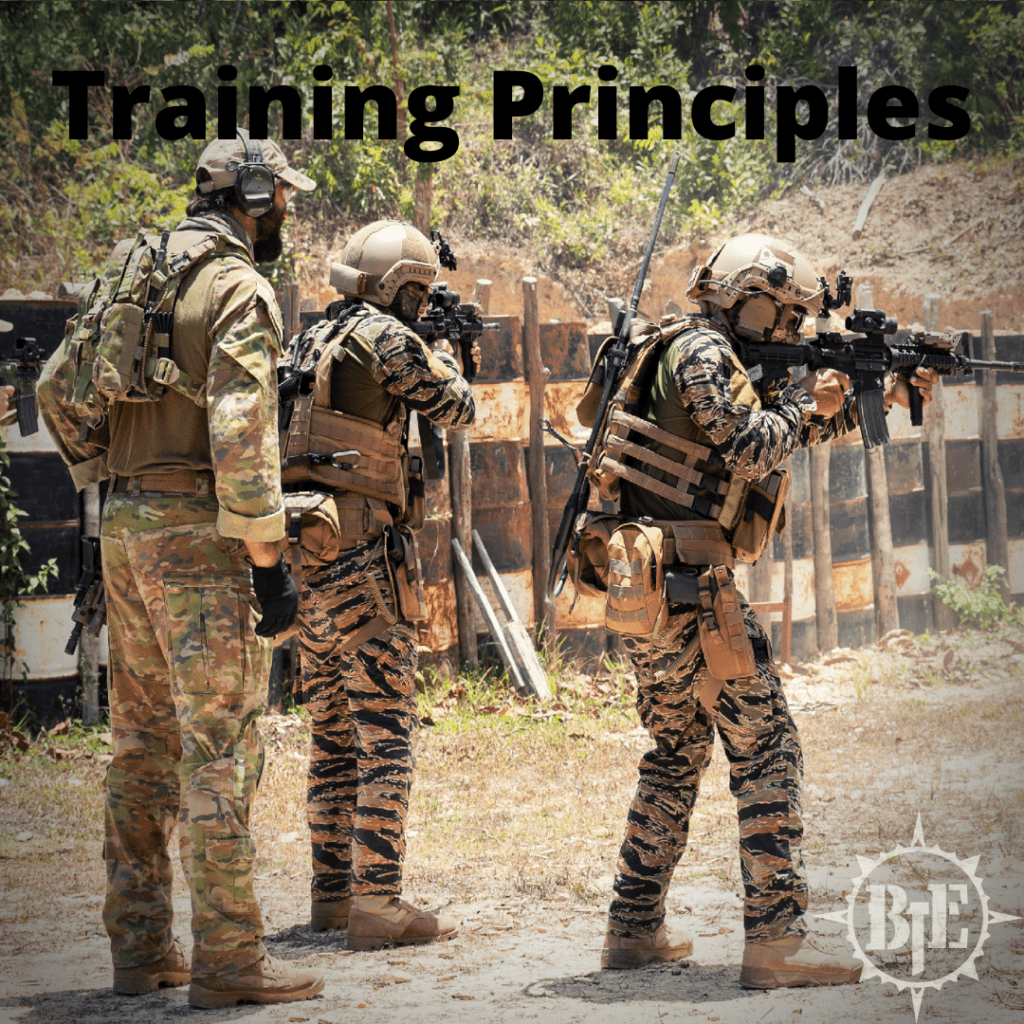Regardless of your age, background, or what you are training for, principles should guide your training process. The following principles can be used to help guide your thinking when developing or considering whether a training plan is appropriate for you.
1 – Specificity
Specificity is the principle that training should stress the exact systems and capabilities needed to execute the task you are training for.
When misapplied, you find people barbell back squatting on bosu balls and juggling handguns while navigating a minefield of agility objects. Don’t be that person.
It’s easy to confuse what is meant but specificity, by focusing on the wrong level of skills that are needed to be a SOF operator.
For example, let’s break down the role strength would play in a SOF job:
- Job: Infil 10 miles with a 50# pack over varied terrain in 2.5 hours, perform a raid that requires breaking down a door and fireman carrying a person 50 yards. Then ruck two miles in 25 minutes to the exfil site.
- One step out: Live training exercises simulating nearly every aspect of the situation mapped out above.
- Two steps out: Ruck 12 miles while navigating at night in an underfed and fatigued state followed by completing a difficult obstacle course.
- Three steps out: Rucking 12 miles in a well-fed and recovered state. Strength training to improve the ability to maintain posture, carry heavy objects, and sprint fast under load when needed.
The military will take care of every step except for the initial one (three steps out) – being a strong and well-conditioned human who can still move well. The greater your development at this initial stage, the more capable and adaptable you will be in the later, more job-specific stages with the military. Trying to replicate your job at the gym misses the point of general training. You need to master the fundamentals before adding stress or complexity. Training of physiological capacities should be guided by the same principles.
Even operators currently deployed need to continue some basic strength and conditioning training to maintain the underlying capabilities. If they neglect this base for too long their on-the-job performance will start to falter. If you’re preparing for selection, you are years away from doing your tactical job and your focus should be on the general capabilities that will allow you to thrive when you shift your emphasis to more specific military training.
To do that, you need to train the specific movements and intensities that lead to physiological changes in your ability to produce force. This is why CrossFit + jogging or doing random metcons is inefficient – the training isn’t specific enough to create a strong adaptation stimulus.
2 – Overload
Your body adapts to stressors based on the magnitude of the stress response. In other words, the stronger the disruption to the normal baseline, the stronger the response is from your body to adapt to the stimulus. However, this only occurs up to a point. If you absolutely crush yourself, your body will have to spend so many resources just getting back to baseline it won’t have enough left to adapt appropriately to the stimulus.
There is a sweet spot with overload, which is why we provide guidelines when talking about methods for strength training, work capacity, running, rucking, etc.
Overload is also why we program training blocks that last anywhere from 3-6 weeks. Longer than this and your body has adapted to the initial overload and you can no longer produce an overload effect with the same method. Shorter than three weeks and you’ll miss out on significant improvements by changing methods before you’ve created a strong overload stimulus.
3 – Recovery
Balancing stress and recovery is essential to facilitate adaptation without compensation. You become more capable during the recovery phase, not during the stressor. Training is only half the work; the other half is managing allostatic load, getting enough sleep, and eating well enough to allow your body to adapt to the training you’ve already done.
If the overload stimulus is strong enough you’ll adapt regardless of your recovery status; but, this will occur at the expense of another system or quality. This is when injuries occur.
Nearly every client we’ve worked with has fallen into this trap – constantly doing more workouts at higher intensities until that ‘out of nowhere’ injury occurred.
Balancing recovery with stress is the key to long-term progress without injury.
You can implement the recovery principle into the training process by using periodization (changing total load from week to week) and monitoring recovery status and adjusting workouts based on that data.
4 – Variation
We all know someone who goes to the gym and does the exact same thing week after week, month after month, and is baffled why they don’t get any more fit. This person doesn’t have enough variation in their program to create a sufficient overload stimulus and the corresponding improvements in fitness.
Changing the stimulus of a workout is the principle of variation. This principle plays out at different time scales:
- Day to day – Emphasis will vary each day over the course of a week (strength, conditioning, work capacity, and recovery days).
- Week to week – Day-to-day structure remains the same, with small changes in sets, reps, and load from week to week. No change in methods.
- Month to month – Methods and exercises shift and build upon one another each month. This leads to larger changes in sets, reps, and load.
- Quarter to quarter (3-ish months) – As your limiting factor changes, you’ll need to make large changes in your day-to-day schedule, methods, load, volume, exercises, etc. to emphasize a new physiological capacity.
As you can see, variation needs to be applied at different levels of programming depending on the time scale. This is what allows for consistent progress.
“Muscle confusion,” random “metcon” programming, or other equally misguided concepts only work for short periods of time because they violate this concept of variation. They provide so much variability that the body never gets an overload stimulus once you have at least a moderate level of fitness.
5 – Idiosyncrasy
Every person has a different background (your training history) and genetics. Both of these factors change how each individual responds to the same training stimulus. While all humans generally adapt to a stimulus in a similar manner, the exact speed and degree of adaptation varies greatly. We call this individual adaptation process idiosyncrasy.
The guidelines provided in our book and articles are guidelines – not a recipe. Your response will be idiosyncratic to you. This is why we give only very general guidelines to programming methods and have gone to great lengths to give you the mental models and principles to make sound decisions based on your personal experience.
Wrap Up
This isn’t an exhaustive list of every principle we utilize when creating training programs, but it will serve as a good baseline for sanity-checking your own programs or any that you’re looking to start.




Great stuff thank you. Found this at the right time in my life. Forward